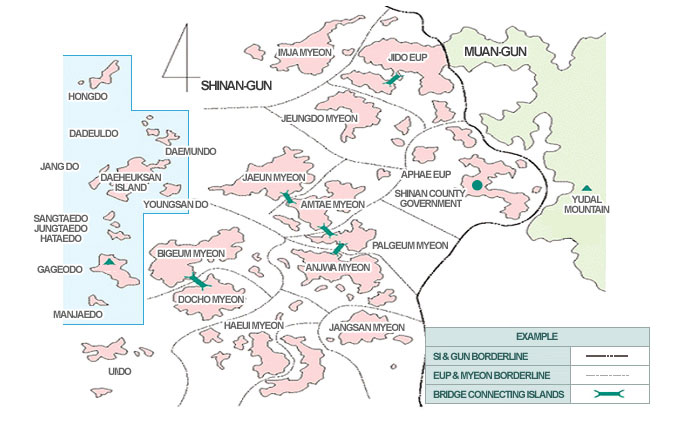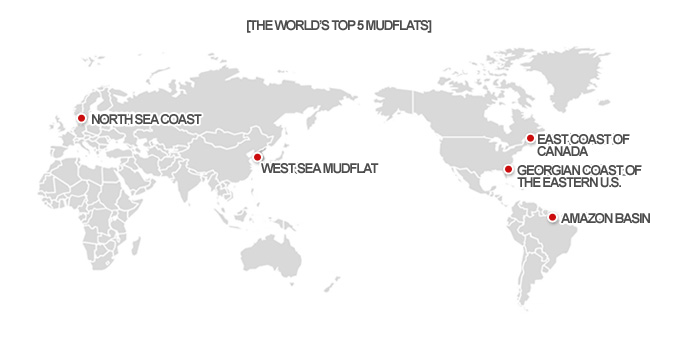Shinan-gun is located in the far southwest part of Korea with fresh air, clean mudflat, unpolluted seawater, abundant sunshine and separated from the continent. In such a blessed natural condition, the worldly recognized high-quality Sea Salt is being produced.
Natural environment
- The east faces Muan-gun and Mokpo si across the sea, the west faces the yellow sea, and the north faces Nakwol archipelago of Youngkwang-gun. The number of Shinan-gun takes up 25% of the total number of islands in Korea. Islands are scattered widely in the yellow sea, so that the waters are wide. Each island has many hills, and few plains. But along the coast, there are spacious plains reclaimed from the coastal mudflats.

- As big islands, there are Anjwado(45.2㎢), Aphaedo(44.3㎢), Bigeumdo(43.1㎢), Dochodo(40.3㎢), Imjado(43.2㎢), Amtaedo(38.7㎢), Jeungdo(37.2㎢), Jangsando(24.3㎢), Haeuido(16.1㎢), and Heuksando(19.7㎢). The waters where Shinan-gun is located are the areas of all continental shelves and the depth of the waters is shallow within 15m. For climate, since the islands are located in the southwest sea of Korea, they have maritime climate. Average temperature of January is 2∼4℃, average temperature of August is 24℃, annual average temperature is 14℃, and annual rainfall is 800∼1,000mm. This is where the cold coastal water of the yellow sea heading south meets the turbulence flow of the yellow sea heading north through the central part of the yellow sea and has many foggy days. The worldly recognized Sea Salt of Shinan is harvested from the mudflat of Shinan-gun which is one of the world's top 5 mudflats. Its production area is more than 50 km away from the land and compared to other areas in the land, it has very good production conditions. The Sea Salt of Shinan is produced in the optimum natural conditions with clean waters of the Pacific Ocean, fresh air, germanium mudflat that is the mine of ecosystem, etc. In accordance with the wellbeing trend, in December, 2007, Jeung do and its surroundings were designated as Slow City, Biguem Daedong saltern was registered as modern heritage site, in May, 2009, the mudflats and salterns of Shinan-gun were designated as UNESCO Biosphere Reserve, etc. and Shinan-gun is reborn as a world-class eco-friendly area.

Ingredients
- Shinan Sea Salt is low in sodium chloride content, but relatively high in moisture and sulfuric acid ion content. What's more, calcium, potassium, magnesium and other mineral contents are much higher than those of Guerande salt in France. For this reason, food processing factories in Japan using Sea Salt or soy-sauce production-sales factories in Japan stick to Shinan Sea Salt only and CJ, Daesang, Nongshim and other leading Korean food-related production/distribution companies are selling various products using Shinan Sea Salt.
Effects
- Our traditional foods (Kimchee, seasoning pastes & sauce, salted seafood, etc.) also need to use the domestic Sea Salt to keep the taste and flavor. When imported salt is used, while the lactic acid fermentation process runs slow, the acetic acid fermentation process runs fast. Thus, once Kimchee is ripened, it turns sour soon. However, when the domestic Sea Salt, especially, Shinan Sea Salt is used, after Kimchee is ripened, it stays the flavor of being properly sour for a long time, compared to Kimchee using imported Sea Salt.
Sea salt of Shinan-gun
- Our traditional foods (Kimchee, seasoning pastes & sauce, salted seafood, etc.) also need to use the domestic Sea Salt to keep the taste and flavor. When imported salt is used, while the lactic acid fermentation process runs slow, the acetic acid fermentation process runs fast. Thus, once Kimchee is ripened, it turns sour soon. However, when the domestic Sea Salt, especially, Shinan Sea Salt is used, after Kimchee is ripened, it stays the flavor of being properly sour for a long time, compared to Kimchee using imported Sea Salt.

